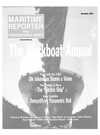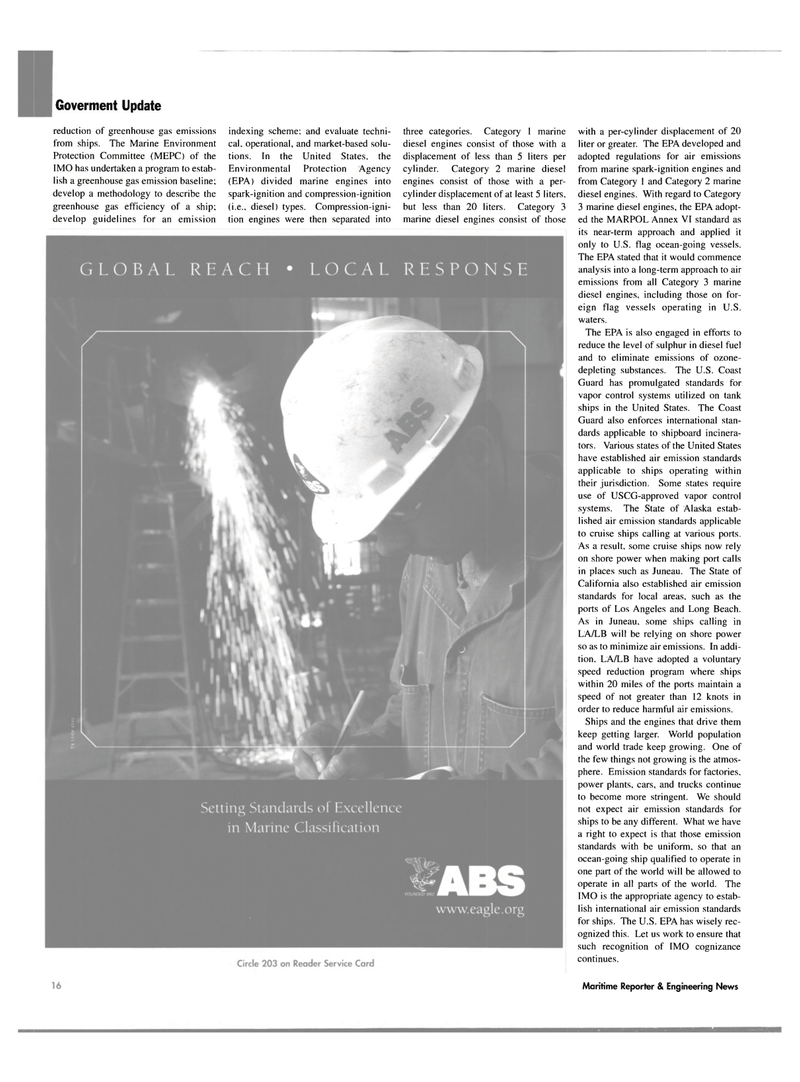
Page 16: of Maritime Reporter Magazine (November 2004)
The Workboat Annual
Read this page in Pdf, Flash or Html5 edition of November 2004 Maritime Reporter Magazine
Goverment Update reduction of greenhouse gas emissions from ships. The Marine Environment
Protection Committee (MEPC) of the
IMO has undertaken a program to estab- lish a greenhouse gas emission baseline; develop a methodology to describe the greenhouse gas efficiency of a ship; develop guidelines for an emission indexing scheme; and evaluate techni- cal. operational, and market-based solu- tions. In the United States, the
Environmental Protection Agency (EPA) divided marine engines into spark-ignition and compression-ignition (i.e.. diesel) types. Compression-igni- tion engines were then separated into three categories. Category 1 marine diesel engines consist of those with a displacement of less than 5 liters per cylinder. Category 2 marine diesel engines consist of those with a per- cylinder displacement of at least 5 liters, but less than 20 liters. Category 3 marine diesel engines consist of those with a per-cylinder displacement of 20 liter or greater. The EPA developed and adopted regulations for air emissions from marine spark-ignition engines and from Category 1 and Category 2 marine diesel engines. With regard to Category 3 marine diesel engines, the EPA adopt- ed the MARPOL Annex VI standard as its near-term approach and applied it only to U.S. flag ocean-going vessels.
The EPA stated that it would commence analysis into a long-term approach to air emissions from all Category 3 marine diesel engines, including those on for- eign flag vessels operating in U.S. waters.
The EPA is also engaged in efforts to reduce the level of sulphur in diesel fuel and to eliminate emissions of ozone- depleting substances. The U.S. Coast
Guard has promulgated standards for vapor control systems utilized on tank ships in the United States. The Coast
Guard also enforces international stan- dards applicable to shipboard incinera- tors. Various states of the United States have established air emission standards applicable to ships operating within their jurisdiction. Some states require use of USCG-approved vapor control systems. The State of Alaska estab- lished air emission standards applicable to cruise ships calling at various ports.
As a result, some cruise ships now rely on shore power when making port calls in places such as Juneau. The State of
California also established air emission standards for local areas, such as the ports of Los Angeles and Long Beach.
As in Juneau, some ships calling in
LA/LB will be relying on shore power so as to minimize air emissions. In addi- tion. LA/LB have adopted a voluntary speed reduction program where ships within 20 miles of the ports maintain a speed of not greater than 12 knots in order to reduce harmful air emissions.
Ships and the engines that drive them keep getting larger. World population and world trade keep growing. One of the few things not growing is the atmos- phere. Emission standards for factories, power plants, cars, and trucks continue to become more stringent. We should not expect air emission standards for ships to be any different. What we have a right to expect is that those emission standards with be uniform, so that an ocean-going ship qualified to operate in one part of the world will be allowed to operate in all parts of the world. The
IMO is the appropriate agency to estab- lish international air emission standards for ships. The U.S. EPA has wisely rec- ognized this. Let us work to ensure that such recognition of IMO cognizance continues.
Maritime Reporter & Engineering News

 15
15

 17
17
